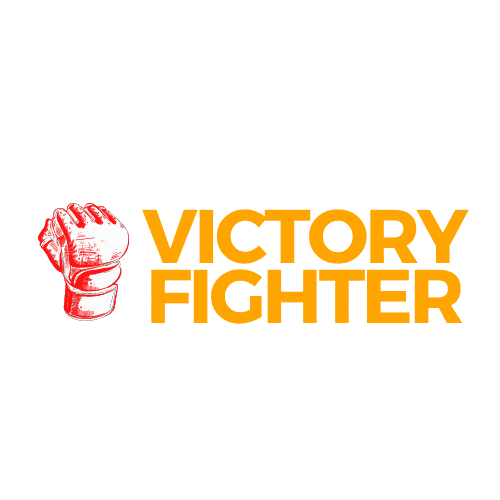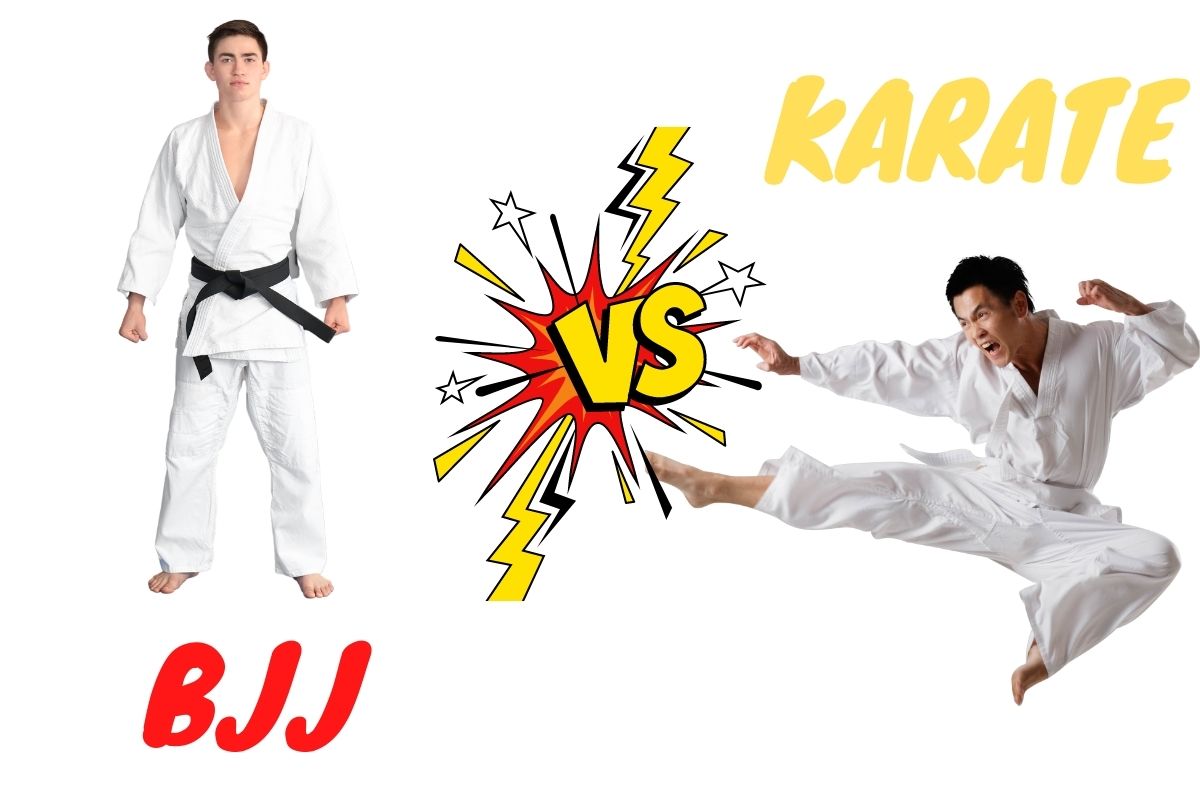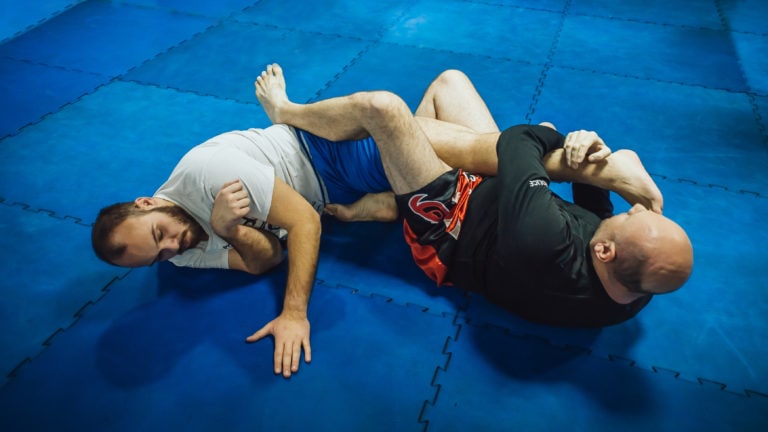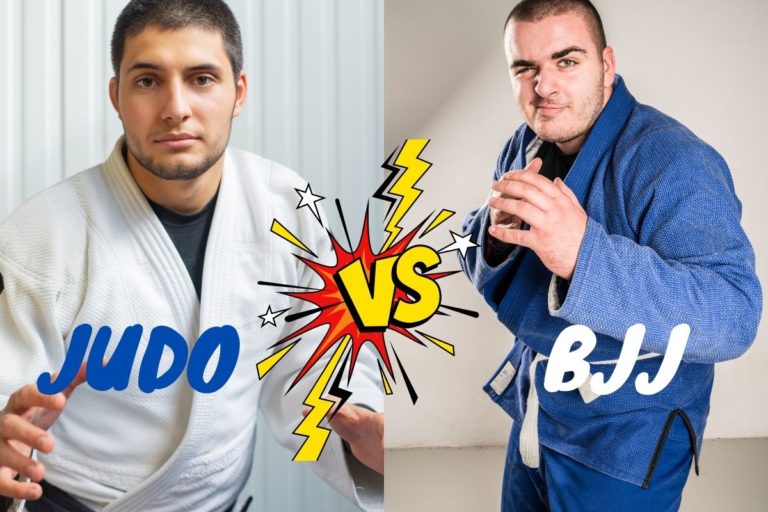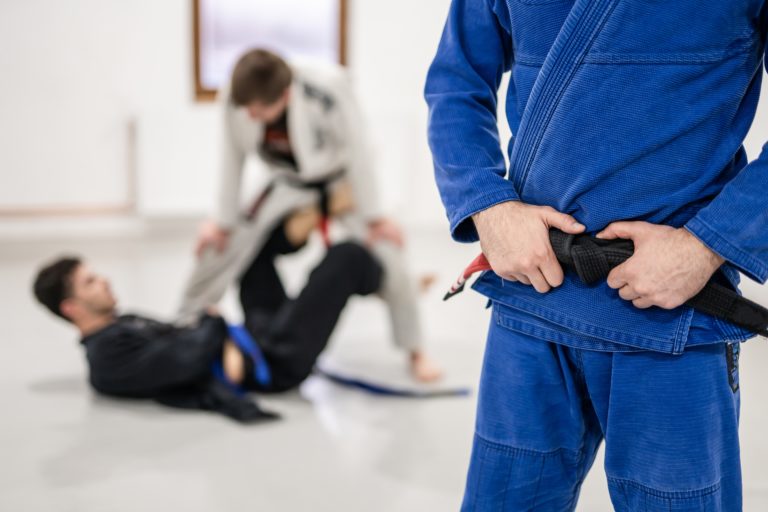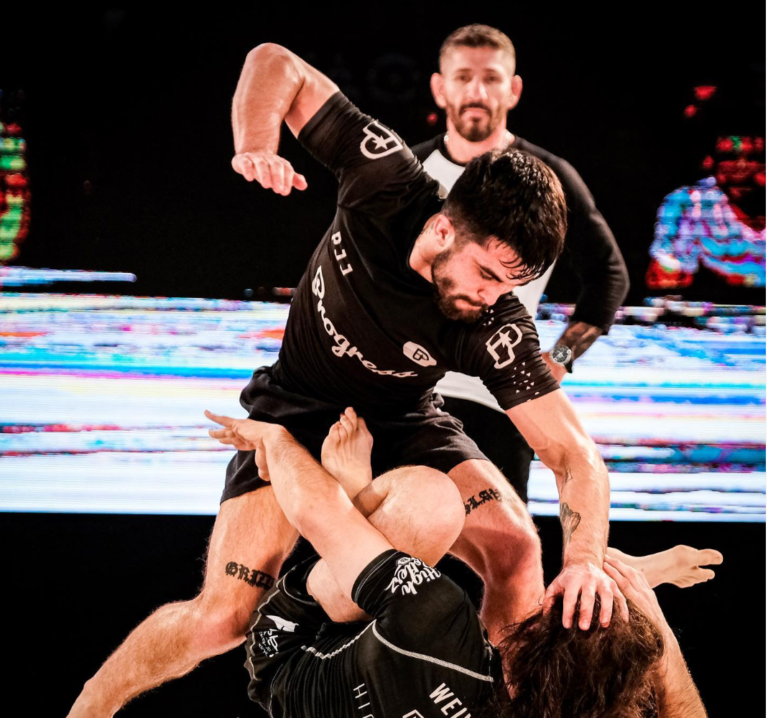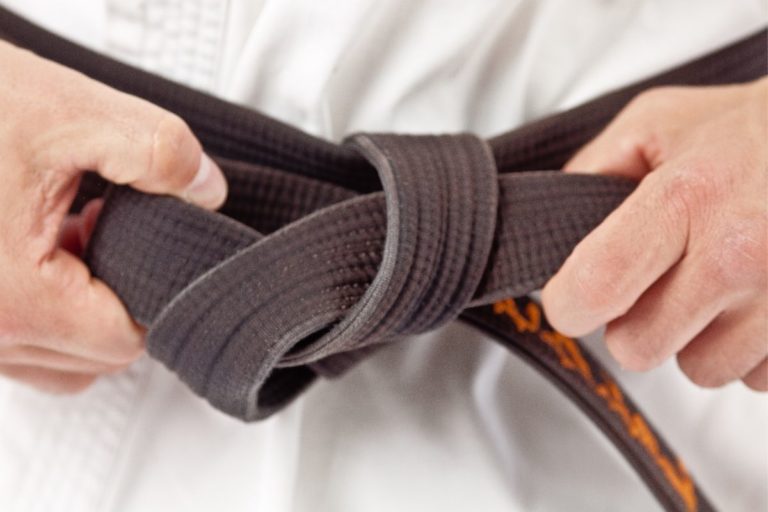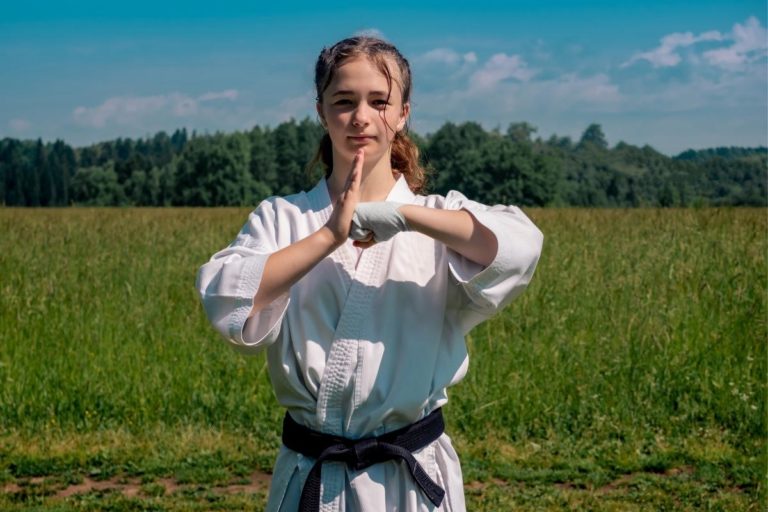BJJ vs Karate — Which One is Better and Why?
BJJ and karate are two separate forms of combat that differ in many ways. In fact, these two are world apart when it comes to most aspects like history and methods of teaching. But which one is better and why, BJJ or Karate?
BJJ is often seen as the most practical combat system. The entire focus is on close range combat using throws to take the fight to the ground first. Then, the main goal is to secure a dominant position, and finish the fight with chokes and joint locks.
Modern karate, on the other side, focuses on fast and direct light contact striking. Most styles include punches and kicks with some basic throws and sweeps. The modern form has moved away from self-defense aspect and is focusing more on competition instead. Does this mean that BJJ is better?
Keep reading this article to learn more about BJJ vs Karate. We will explore all the differences, and how these two martial arts compare in various aspects such as self-defense and MMA. Enjoy!
BJJ vs Karate — what are the main differences?
BJJ and Karate are two separate arts that do not have much in common. Each of the two has its own techniques, methods of teaching, philosophies, and rules. To better understand which one is better and why, let’s start with how these two differ in various aspects. Here is a detailed look:
History
BJJ is a system designed by the famous Gracie family which has origins in Judo, which further originates from Japanese jujutsu. Brothers Carlos and Helio Gracie, both skilled judokas, used judo as a base to develop their own style in the 1920s. But their creation would become popular with the birth of MMA in the early 90s when BJJ dominated the scene in the opening years.
The earliest records of karate go all the way back to the 15th century the Ryukyu Kingdom, which is the present Okinawa Island. It has a long history and tradition, but it became popular when Japan annexed the Islands in the 19th century. This allowed skilled karatekas to move and popularize karate on the main islands of Japan in the 20th century and it didn’t take long for karate to become a national sport.
Concept and Techniques
In its initial form, BJJ is a hand to hand system designed for self-defense and real combat. It is, perhaps, the only martial art that allows a small person to beat a physically bigger attacker. People call it “gentle art” because it is a very complex, technical, and strategic system where athletes must think three steps in advance. It consists of different throws and takedowns, positions, and finishing moves like chokes and joint locks. Here are some of the most popular techniques:
- Takedowns: single/double leg, low single, ankle pick
- Throws: Tomoe Nage, Uchi Mata, Yoko Sumi Gaeshi
- Various types of trips and sweeps
- Dominant positions: side-control, full-mount, back-mount
- Chokeholds: Americana, rear-naked choke, triangle choke
- Joint locks: leglock, kneebar, armbar, kimura
Karate is also a martial art created with self-defense in mind that focuses more on striking. The modern form puts a lot of emphasis on light contact using direct punches and kicks and mixing those with fast footwork. The main point is to overwhelm the opponent with speed, precision, and better timing instead of using sheer force. The key is to beat the opponent without causing injuries, which is one of the philosophies of karate.
Different styles
BJJ has three main styles:
- Gi — is the most popular style where all students must wear a Gi uniform that is very similar to the one in Judo. It consists of a jacket, pants, and a colored rank belt around the waist.
- No-Gi — is a style where, as its name suggests, students do not wear any uniform. In some way, this style was designed to be more in line with MMA fighting.
- Gracie jiu-jitsu– is the initial style of BJJ that focuses entirely on the self-defense aspect. While the other two emphasize competition, Gracie Jiu Jitsu is all about real fighting.
Karate, on the other side, has dozens of different styles, and listing them all requires a separate article. But, it is crucial to know that the four major styles are:
- Shito-Ryu
- Wado-Ryu
- Shotokan
- Goju-Ryu
These four styles have later influenced the birth of many other styles like Kyokushin, Enshin, and Ashihara.
BJJ vs Karate — which one is harder to learn?
On paper, BJJ takes a lot more time to master because it is more complex, and the progress through the belt ranks is slower. However, time is just one of many aspects that determines how hard learning is. To better understand which one is harder, you have to take the following aspects into the consideration too:
Time to master — BJJ
On average, BJJ students need to spend around 10 years training hard before they reach a black belt rank. Of course, this varies between different schools, and even countries you train in. Other factors are your talent, how dedicated you are, and passionate.
Karate takes less time, around 3 to 5 years of training to get a black belt. But bear in mind that there are even more variations in karate because of so many different styles. Still, even if you train in the most legitimate dojo, it would still take less time to master than BJJ.
More technical — BJJ
BJJ techniques are very hard to master and physically harder to perform. Apart from strength, and cardio, you have to be flexible, agile, strategic, and methodical. There are so many variables that people often refer to BJJ as a “human chess match”. It takes time to develop balance, and coordination, learn how to distribute weight, and learn all the moves.
Karate is also versatile but not that complex to master because most of the techniques are direct and easy to understand and apply. You won’t have a hard time learning the basics as striking has always been closer to human body mechanics and instincts than grappling.
More intense and dangerous: BJJ
Rolling on the ground and playing with submissions is fun, but also puts a lot of stress on your body. It is exhausting, and even painful because there is a lot of pulling on the joints and putting your body in awkward positions.
Karate is a striking martial art, but at the same time, not as hard on your body as BJJ. This is due to the fact that there is no full-contact sparring in most styles and forms as the emphasis is on speed and technique. Apart from light contact, all students must wear full protective gear all the time, which increases safety. The only exceptions are traditional styles in Okinawa, and of course, Kyokushin karate which is one of the hardest martial arts.
BJJ or Karate for MMA?
BJJ plays a big role in modern MMA, much bigger than any style or form of karate. Thus, if you want to become an MMA fighter and you are looking for a martial art where you can develop a solid base, be sure to choose BJJ. Don’t get us wrong, karate is also more than present in cage fighting, but not as much.
Learning curve
First of all, studies have shown that most UFC champions have come from wrestling and BJJ, meaning that grappling skills are more important than striking. However, it takes more time to master grappling than striking, which leads us to the learning curve.
When they transition to MMA, BJJ fighters must learn how to strike and karatekas how to grapple. On average, it takes around a year or two for a grappler to develop solid Muay Thai skills, and with that, an all-around skill set. However, karateka needs a minimum of 5 years of learning to develop an equal level of grappling skills.
Karate does not fit well within the MMA rules
The skills and techniques that you learn in Karate do not transition well into modern MMA fighting due to various reasons. First, MMA is dynamic and fluid freestyle combat where there is no point-scoring or referee resetting the action each time someone gets hit. Thus, you will have a hard time adapting to those rules.
Technical drawbacks of karate
Next, most karate styles are light contact. Or in other words, your body won’t be conditioned enough to absorb full-blown shots and punishment, and the same stands for your mind. On top of that, you will have to change your mindset, become more aggressive, and start using full force to inflict damage.
Last but not least, karate as a striking concept is full of holes. For instance, all the fighters tend to drop their hands low and leave their chin and body exposed. They do not perform well at close range at all, not to mention the lack of grappling and ground fighting.
BJJ vs Karate — which one is better for self-defense?
BJJ is often seen as the most effective martial art for self-defense, and with that, it is a better option than most styles of karate. Though it has certain limitations, notably when it comes to striking, the skills and techniques you learn in BJJ are more practical for freestyle combat, and here is why.
It is more in line with freestyle combat
The best example is the domination of BJJ in MMA in the early 90s when the sport was a freestyle combat without the rules. Or in other words, UFC events were Legal Street fights. Back then, fighters were experts in just one style of fighting and there were many style vs style matchups. Representing BJJ, Royce Gracie beat fighters from all other styles like boxing, karate, and wrestling to win three straight UFC tournaments. Why is this important? Well, it shows you what would happen in most street fights where there are no rules.
Better instincts and reactions
All humans have the ability to throw and block a strike, move their heads out of the way, and do many other things because these are all instinctive reactions. But BJJ is all about leverage, complex techniques, and balance. You can’t use sheer force to stop a takedown or muscle your way out of a submission. No, you must know exact procedures and have the skills to pull it off, which takes many years to master.
Works better at close range
Street fighting includes a lot of grabbing and pulling on the clothing whether you are in the open or closed space and this is where BJJ shines. Skilled fighters need to grab just a single part of your body to get you in serious trouble and finish the fight. On the other side, Karate does not work well at close range as they all need a lot of space to operate and apply footwork and long-range strikes.
More oriented towards self-defense
Modern-day karate practice puts a lot of emphasis on light contact, competition, and point fighting rules. This is bad for self-defense because, for instance, there is no fluid action in karate. Each time you score a point by landing a clean strike in a match or sparring the action resets in the center. Also, students must be careful not to use too much force because they might get penalized for doing so as the focus is on speed and technique. All of this is terrible for a self-defense scenario where there are no rules and makes BJJ far more effective.
BJJ vs Karate — who would win in a fight?
When it is all said and done, athletes trained in BJJ have better chances of beating karatekas, regardless of the style and form. Of course, there are scenarios where skilled karatekas have better chances of winning, but not many. The relentless grappling, pressure and ground fighting that BJJ brings to the table is simply too much for any karateka to deal with.
The thing is, modern karate and most dojos around the world put too much emphasis on competition. The only exceptions are dojos that embrace a traditional method of teaching, but you might have a hard time finding one. Sooner or later, you would need to accept the fact that the evolution of karate has gone the wrong way a long time ago. It is not as effective in freestyle combat as it once was, especially not against such a versatile system as BJJ is.
That being said, BJJ fighters would have a much easier time dealing with striking attacks that karate brings to the table. Even if they get touched, remember that karatekas are not trained to use full force. This will give grapplers plenty of chances to time the entry, get a takedown with ease, and place a submission even easier to finish the fight. There is a chance that this fight might go the other way around, but a very, very small one.
BJJ vs karate — which one is better for you?
Which one is better for you comes down to your personal preference. It all depends on your individual goals and what you want to achieve with your training in the long run. However, here are some final thoughts that might help you make the right choice.
BJJ is a better option if you want to learn self-defense tactics or switch over to MMA later at some point. It is also more oriented toward the modern-day lifestyle and even a part of the culture to some extent. It really doesn’t matter if you are a 70 year old or a 10 year old, BJJ classes are designed for all ages and genders.
Karate is also good for people of all ages and genders. However, bear in mind that, over time, karate has become popular among kids and you will rarely see any adults joining the classes. Instead, most teenagers and young people in their early 20s choose more effective martial arts like Muay Thai, MMA, or BJJ. Not many people are heavy into learning how to compete, point fighting rules, traditions and philosophies. Thus, karate has become a very popular option for kids as their introduction into the world of martial arts.
